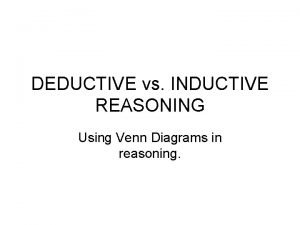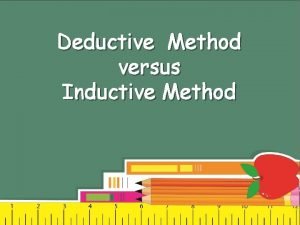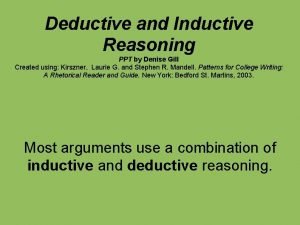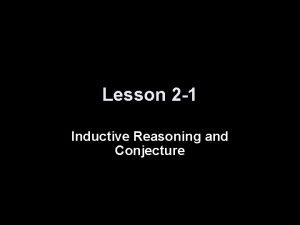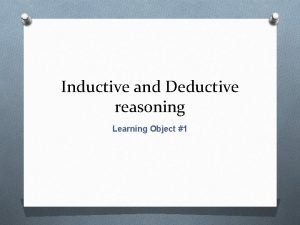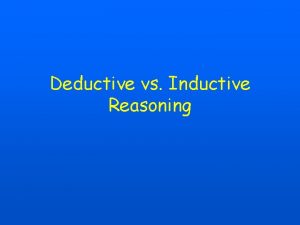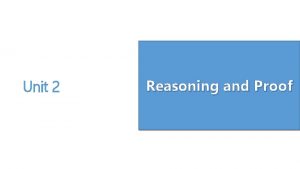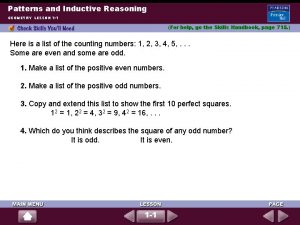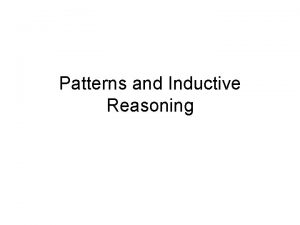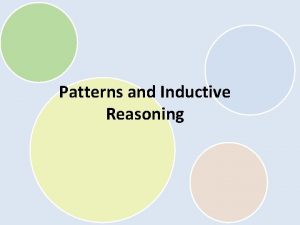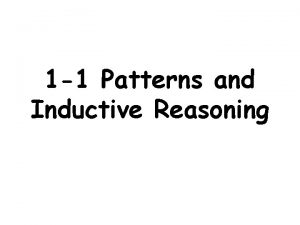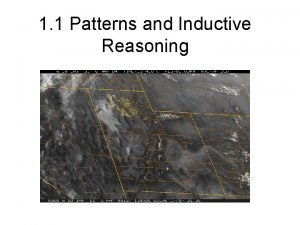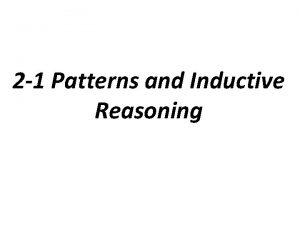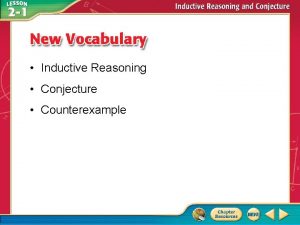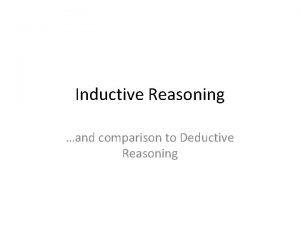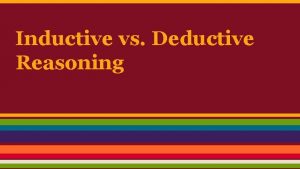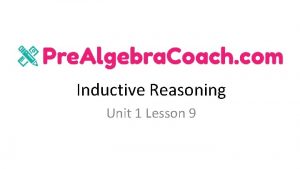Chapter 9 Evaluate Inductive Reasoning and Spot Inductive















- Slides: 15

Chapter 9 Evaluate Inductive Reasoning and Spot Inductive Fallacies © 2013 Pearson Education, Inc. All rights reserved.

Inductions and the Evidence at Hand • Evaluating Generalizations – A generalization may be based on data gathered systematically or unsystematically – The premises report personal experiences, conversations focused on these topics: • Or information derived from historical records or opinion surveys © 2013 Pearson Education, Inc. All rights reserved.

Inductions and the Evidence at Hand – People over the age of 60 tend to prefer to listen to oldies – 73 percent of the hotel room beds in this city are infested with bedbugs – It’s probably going to be cloudy and cold in San Francisco if you go in August © 2013 Pearson Education, Inc. All rights reserved.

Inductions and the Evidence at Hand – It is easy to imagine scenarios in which the information in the premises is true • But the conclusion may not apply – To evaluate the logical strength of inductive generalizations: • We need to do more than find a single counterexample © 2013 Pearson Education, Inc. All rights reserved.

Inductions and the Evidence at Hand – Asking four questions and finding satisfactory answers to each of them • • Was the Correct Group Sampled? Were the Data Obtained in an Effective Way? Were Enough Cases Considered? Was the Sample Representatively Structured? © 2013 Pearson Education, Inc. All rights reserved.

Inductions and the Evidence at Hand • Coincidences, Correlations, and Causes – The progression from coincidence to correlation to causal explanations marks our: • Progress in being able to explain and to predict events – As more data are systematically gathered analyzed: © 2013 Pearson Education, Inc. All rights reserved.

Inductions and the Evidence at Hand • We may discover that the two events are statistically correlated – Which Report Should We Believe and Why? The Devil Is in the details! – Coincidences • We can use inductive reasoning and statistical facts to calculate the probabilities that: © 2013 Pearson Education, Inc. All rights reserved.

Inductions and the Evidence at Hand – A given coincidence might occur – Correlations • Describe the degree to which two different sets of events are aligned • Well-researched correlations can be powerful tools – Causes • Causal explanations are desirable because they: © 2013 Pearson Education, Inc. All rights reserved.

Inductions and the Evidence at Hand – Enable us to explain, predict, and control parts of the natural world – It is not always possible to move all the way: • From coincidence to correlation to causal explanation in every field of inquiry • Fallacies Masquerading as Strong Inductive Arguments © 2013 Pearson Education, Inc. All rights reserved.

Inductions and the Evidence at Hand • Erroneous Generalization – At times, we generalize from too little information: • Exaggerating the claim beyond what the data support – Playing with Numbers © 2013 Pearson Education, Inc. All rights reserved.

Inductions and the Evidence at Hand – False Dilemma • A real dilemma is a situation in which all our choices are bad – The Gambler’s Fallacy • Random events, by definition, are not causally connected © 2013 Pearson Education, Inc. All rights reserved.

Inductions and the Evidence at Hand – False Cause • When two events occur one right after the other: – We may mistakenly infer that the first is the cause of the second • Other mistakes often grouped under the: – Broad heading of False Cause Fallacies result from confusing symptoms © 2013 Pearson Education, Inc. All rights reserved.

Inductions and the Evidence at Hand – Slippery Slope • Everyone knows that simply beginning something is no assurance that it will be completed • The Slippery Slope Fallacy makes the false assumption that discrete events are linked together • The first step in the process necessarily results in: – Some significant, usually bad, result way down the road © 2013 Pearson Education, Inc. All rights reserved.

© 2013 Pearson Education, Inc. All rights reserved.

© 2013 Pearson Education, Inc. All rights reserved.
 Deductive reasoning
Deductive reasoning Example of deductive reasoning
Example of deductive reasoning V
V Difference between inductive and deductive reasoning
Difference between inductive and deductive reasoning Differences between deductive and inductive reasoning
Differences between deductive and inductive reasoning Every quiz has been easy. therefore the test will be easy
Every quiz has been easy. therefore the test will be easy Inductive reasoning is reasoning based on patterns
Inductive reasoning is reasoning based on patterns Deductive and inductive reasoning venn diagram
Deductive and inductive reasoning venn diagram Inductive method
Inductive method Types of reasoning ppt
Types of reasoning ppt 2-1 inductive reasoning and conjecture
2-1 inductive reasoning and conjecture Example of a deductive argument
Example of a deductive argument Inductive arguments
Inductive arguments Deductive and inductive reasoning venn diagram
Deductive and inductive reasoning venn diagram Unit 2 logic and proof inductive reasoning
Unit 2 logic and proof inductive reasoning Lesson 2-1 patterns and inductive reasoning answers
Lesson 2-1 patterns and inductive reasoning answers







